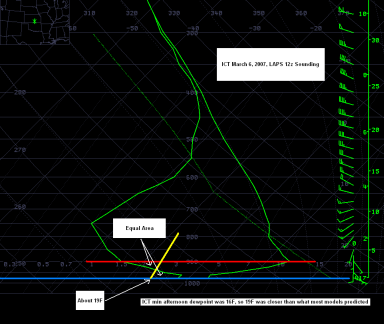Analysis of the March 6th, 2007 South-central and Southeast Kansas Fire Weather Event
Andrew D. Kleinsasser
National Weather Service, Wichita, KS
1. Introduction
On the afternoon of March 6th, 2007, the combination of stout southwesterly winds, low relative humidities, and critical fuels contributed to extreme fire danger across most of south-central and southeast Kansas, along with southern portions of central Kansas. Consequently, the first ever Red Flag Warning (RFW) was issued for all of southeast Kansas, generally along and east of the Kansas Turnpike (I-35). Red Flag criteria was met for most of south-central and portions of central Kansas as well, but fuels were not considered "critical." Most (but not all) short and medium range numerical model guidance poorly anticipated the red flag conditions within 24 hours of the event, particularly dewpoints and to some extent wind speeds. This poor model performance contributed to a slower forecaster recognition of the situation, which in turn delayed the RFW issuance until late in the morning on March 6th. Note: images can be enlarged by left-clicking on them.
2. Synoptic Overview
The day started out seemingly benign from a surface analysis standpoint, but the very dry airmass south of the quasi-stationary frontal boundary would quickly be realized per strong mixing as the morning progressed. Refer to Figures 1, 2 and 3 below.
3. Numerical Model Performance
As stated in the introduction, most short and medium range model guidance drastically over-forecasted dewpoints on March 6th, with the exception of the RUC, which drastically under-forecasted dewpoints. The models, to a somewhat lesser extent, under-forecasted wind speed as well. However, the RUC and NAM were closer to reality than the GFS with regard to dewpoint and wind speed. All models under-forecasted daytime temperatures as well. The combination of higher than anticipated temperatures and lower than anticipated dewpoints resulted in lower than anticipated afternoon relative humidities, which fell well below 20% across much of south-central and southeast Kansas. The below images (Figures 4, 5, 6, 7, 8, and 9) will focus primarily on the over-forecasted dewpoints and under-forecasted wind speeds. Refer to the cursor readout over central Harper County for dewpoint readings.
4. Review of the Equal Area Method: Forecasting Minimum Afternoon Dewpoints Using the Morning Sounding
|
Recall from the 10 February 2006 Harvey County Fire Review (Schreck and Cook, 2006) that the minimum afternoon dewpoint can be forecasted with decent accuracy using just a morning sounding. However, keep in mind that the equal area method does not take into account moisture advection or major airmass changes between the morning sounding and the afternoon. Included here are the steps outlining the equal area method along with a graphic to help visualize the process (Figure 12):
Applying the equal area method to the 12z ICT LAPS sounding indicated an afternoon minimum dewpoint dropping to near 19F. The actual ICT afternoon minimum dewpoint was 16F. The NAM and GFS 12z numerical model output suggested minimum afternoon dewpoints in the mid-20s and the mid-30s, respectively, 10-20 degrees higher than reality. So the equal area method was by far superior to the NAM and GFS with regard to forecasting dewpoints. |
 |
5. Summary and Discussion
Critical fuels, strong southwesterly winds, and low relative humidities on the afternoon of March 6th, 2007 contributed to extreme fire danger across a significant portion of central, south-central, and southeast Kansas. This prompted the first issuance of a Red Flag Warning (RFW) from the National Weather Service Office in Wichita. The forecast for this event was quite difficult given the poor moisture resolution by the numerical weather prediction models.
It was found through this review that utilization of the equal area method to forecast dewpoints should be used for analyzing environments that could be favorable for extreme fire danger. This method produced, in this case and previous cases assessed, better results for afternoon dewpoint minimums when a deep mixed layer exists. Caveats do exist with this method when strong moisture advection is occurring or expected, so it is suggest to analyze upstream environments when this is the case.
6. References
Schreck, M. and Cook, K.R. 2006: Major Grass Fire in Harvey County, NWS ICT Science and Education Publications